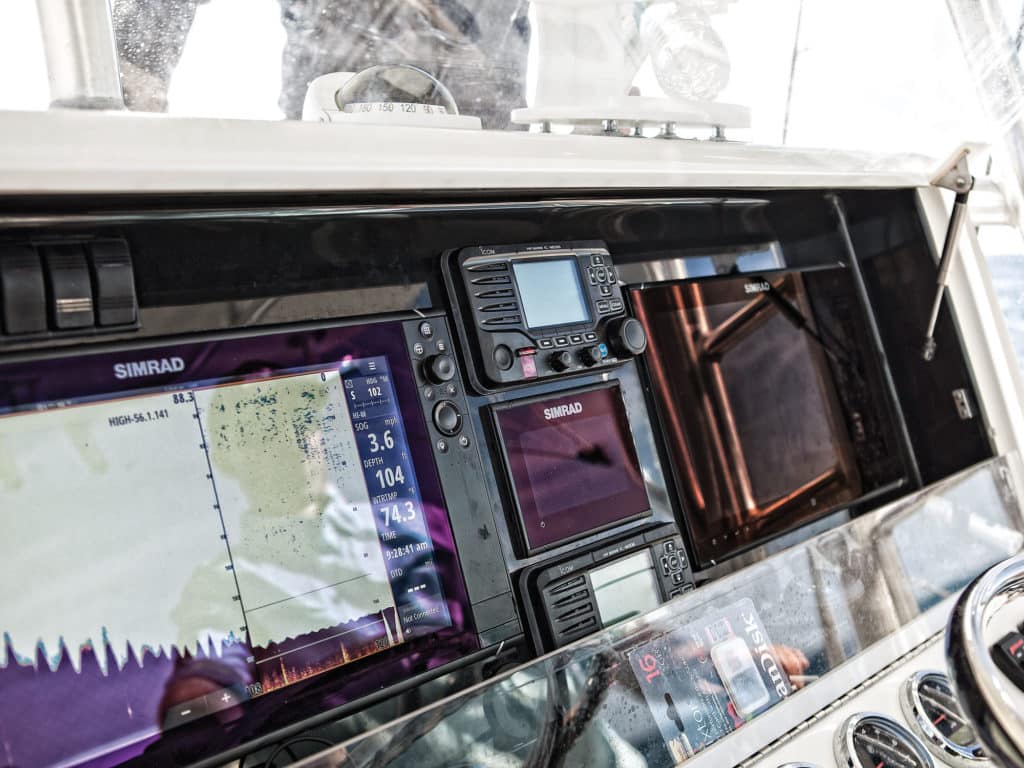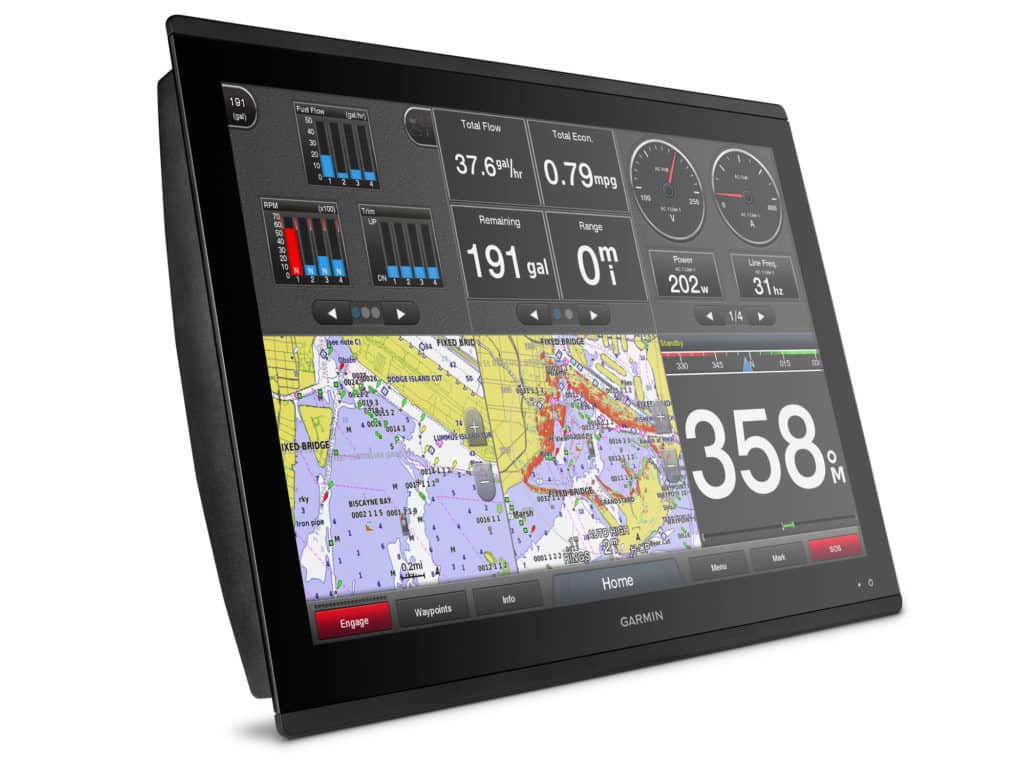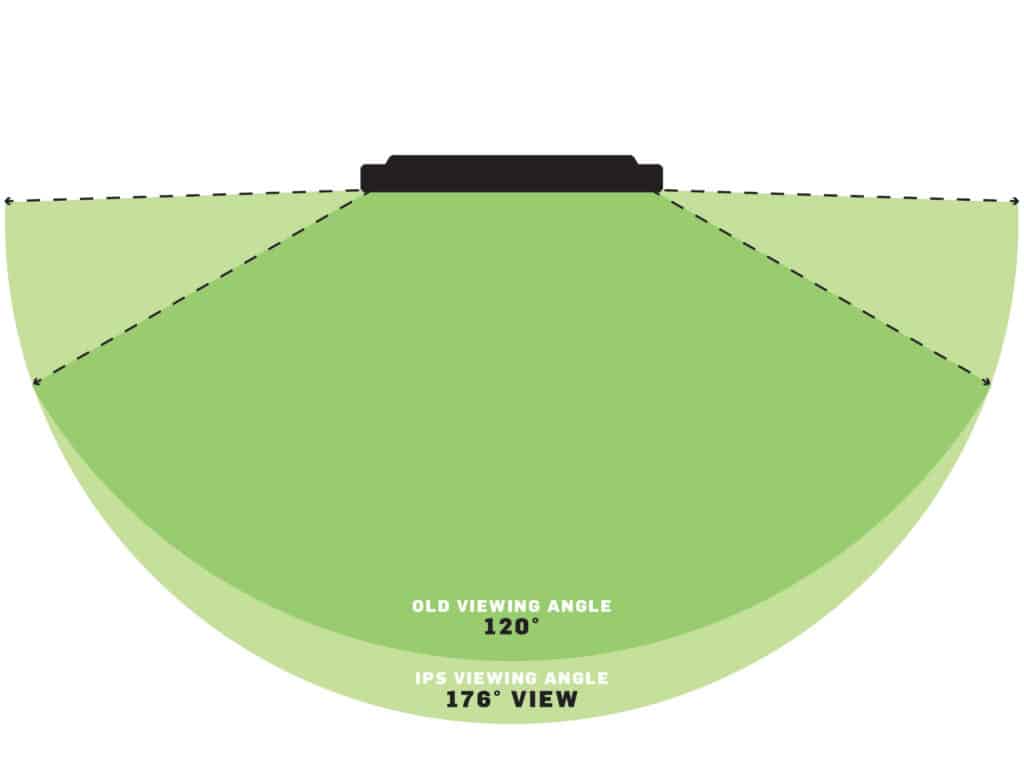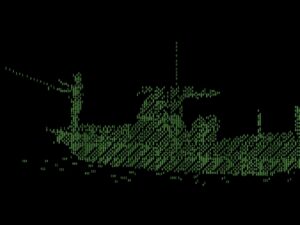
Today’s multifunction displays (MFDs) are technological marvels, but they’re not always easy to read from a side angle. Color, contrast and detail on some LCD screens start to dissipate once the viewing angle exceeds 120 degrees. Wearing polarized sunglasses tends to exacerbate the issue.
New MFDs are changing all this. Technology known as in-plane switching (IPS) has the ability to widen the viewing angle to 176 degrees, says David Dunn, director of sales and marketing for Garmin Marine, which introduced IPS to the marine market early last year in its GPSMap 8400/8600 glass-helm MFDs, which include displays as large as 24 inches.
“Even in bright daylight, these displays are viewable from a much wider angle [than existing LCD screens],” Dunn says. While these MFDs offer a number of advanced features, a wider viewing angle is the number one benefit, he believes.
More recently, Lowrance and Simrad have debuted new MFDs featuring IPS technology in their HDS Carbon and NSS evo3 series, respectively. Trade-named SolarMax HD, the IPS screens found in the HDS Carbon displays are as large as 12 inches, and they go up to16 inches in the NSS evo3 screens.
As a result of IPS technology, viewing angles on these full-feature MFDs have increased by 80 percent over previous displays, says Daren Cole, global brand manager for Lowrance and Simrad. “This is definitely where the industry is going,” Cole says.
Indeed, in my discussions with other marine electronics brands, I have learned that plans are afoot to bring IPS technology to more MFDs in the future.

IPS Origins
While relatively new to marine electronics, IPS technology has been around for a few years. It’s currently found in many laptop computer screens and desktop monitors, as well as in some flat-panel LCD TVs.
In simple terms, with IPS, the liquid crystals align in horizontal, parallel rows, as opposed to VA (vertical alignment) or TN (twisted nematic) displays. The horizontal alignment is what enhances the viewing angle. In addition, electrical current passing through the liquid crystals of IPS displays creates a polarizing effect that transmits light more precisely for crisper colors and clearer images.
“We needed displays that match the resolution of our high-definition sonar technologies such as StructureScan HD and other advanced features,” Cole says. The SolarMax HD screens using IPS offer that definition.
The technology also results in deeper blacks, richer colors and greater resolution, Dunn points out.
IPS displays are also more stable, which makes them perform well as touchscreens. You won’t get the so-called “tailing,” or lightening of the panel, when you swipe or tap the screen, a trait that occurred on some of the older LCD screens.
IPS technology gives new displays the ability to widen the viewing angle to 176 degrees, a great improvement over prior LCD screens.
Cost Factor
The latest technology carries a higher price. At Garmin, for example, the large, high-definition IPS screens in the GPSMap 8400/8600 series cost 50 percent more than previous displays of comparable size. This is why Garmin chose to use IPS initially in its big glass-helm displays.
These MFDs find application largely on yachts, a market that tends to be less price sensitive than others. Garmin GPSMap 8400/8600 series MFD prices start at $7,399.99. At the same time, Dunn believes that cost will come down as mass production of IPS displays in the consumer electronics markets results in economies of scale.
For smaller displays, the cost of IPS technology seems to have already come down, according to Cole. His company has been able to integrate these screens into the HDS Carbon and NSS evo3 series without raising retail prices.
“The Lowrance HDS Carbon pricing is the same as when we introduced the previous generation, HDS Gen3, a few years ago,” he says. Prices for the HDS Carbon series start at $2,099, while the NSS evo3 series starts at $1,299.

Wide Benefits
How does this technology benefit boating anglers? For starters, on many fishing boats, there are two and sometimes three MFDs flush- or surface-mounted into the dash panel. That means one or two of the displays are not directly in front of the helmsman.
In my experience, the captain sometimes needs to crane his neck to get a good look at information on screens to the left or right of the wheel. Clearly viewable over nearly a 180-degree arc, IPS screens resolve this issue. No longer does the captain need to lean from side to side to view all of his helm displays. This also enhances safety by minimizing the amount of time the helmsman needs to take his eyes off the water ahead.
The wider angle grants better viewing while away from the helm, such as when fishing from the gunwale. “You can view the displays clearly from just about anywhere aft of the helm,” Cole says.
The higher resolution of Garmin’s IPS displays also supports a greater number of screen splits. “As a result, on each GPSMap 8400/8600 MFD, a six-way screen split is now possible,” Dunn says. Previous LCD technology would only have allowed a four-way split, Dunn reports.
The sharper details and crisper colors allow anglers to take full advantage of high-definition sonar systems such as StructureScan HD on Lowrance and Simrad models, says Cole.
Dunn also points to highly detailed electronic chart and radar returns, which read better with greater-clarity IPS displays. “As you add more detail to a chart or to a radar screen, the need for more resolution increases,” Dunn explains. IPS displays deliver that resolution and let you view it from greater angles than ever before. Look for an increasing number of these MFDs in the future.
Brand/Series / Available Display Sizes / MSRP Range
Garmin GPSMap 8400/8600 / 17, 22 and 24 inches / $7,399.99 to $11,999.99
Lowrance HDS Carbon / 7, 9 and 12 inches / $2,099 to $3,399
Simrad NSS evo3 7, 9, 12 and 16 inches / $1,299 to $5,499









